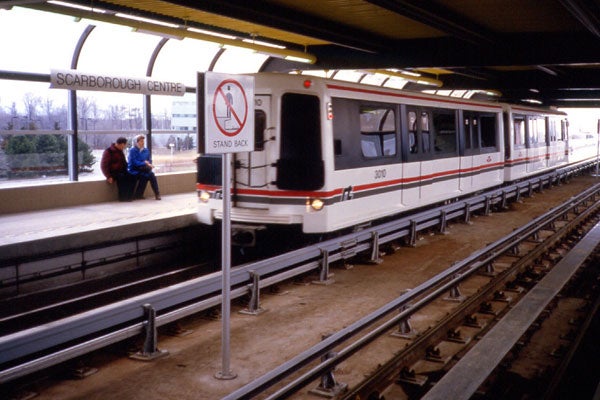
Scarborough needs light rapid transit, experts say
Published: March 11, 2015
LRT along major east-west arterial roads make the most sense for Scarborough’s urban makeup, according to a new report on rapid transit options from the University of Toronto.
“A critical aspect that’s been neglected in recent debates on transit investments in Scarborough is the potential for land redevelopment and intensification in areas near proposed transit stations,” said U of T Scarborough Professor André Sorensen, who authored the 42-page report along with U of T Associate Professor Paul Hess. (Read the report: Choices for Scarborough: Transit, Walking and Intensification in Toronto's Inner Suburbs.)
 The pair mapped land use, street networks, pedestrian access to transit stops and development potential in the corridors that could be served by the different rapid transit options under consideration for Scarborough. They suggest that building a high-capacity rapid transit line in low-intensity suburban areas only makes sense if it’s possible to redevelop and intensify lands within walking distance of the transit stops.
The pair mapped land use, street networks, pedestrian access to transit stops and development potential in the corridors that could be served by the different rapid transit options under consideration for Scarborough. They suggest that building a high-capacity rapid transit line in low-intensity suburban areas only makes sense if it’s possible to redevelop and intensify lands within walking distance of the transit stops.
“The best opportunities for redevelopment exist along Scarborough’s east-west arterials, such as Eglinton and Sheppard, because they have large lots, wide property frontages and currently have low intensity of land use,” said Sorensen, an urban geographer known for his studies of urban regeneration in cities such as Tokyo.
Toronto’s suburbs were originally designed to resist gradual change in residential areas, notes Sorensen. There are rules against intensification and, even today, suggestions of redevelopment are often met with strong opposition from residents. As a result, few areas provide opportunities for significant redevelopment.
Sorensen and Hess conclude that LRT lines such as those proposed by Transit City are not only cheaper and faster to build than a subway, they also offer greater potential for spurring much-needed reinvestment in the area.
By comparison the city council’s plan to build the Scarborough subway extension from Kennedy to Sheppard Avenue would be expensive, accessible to far fewer potential riders from the surrounding neighbourhoods and offer much lower potential for redevelopment along the corridor.
 “LRT offers a longer set of lines and is a much better fit with the existing landscape in Scarborough, including both where the population is and where the jobs are today and where they will likely grow in the future through redevelopment and intensification,” said Sorensen (pictured at left in photo by Ken Jones.).
“LRT offers a longer set of lines and is a much better fit with the existing landscape in Scarborough, including both where the population is and where the jobs are today and where they will likely grow in the future through redevelopment and intensification,” said Sorensen (pictured at left in photo by Ken Jones.).
The report also says rapid transit planning has become intensely political, focusing too narrowly on routes, ridership capacity and the projected cost of various lines while neglecting important elements of how areas such as Scarborough were developed, which “sets the stage” for development and transit opportunities.
“Understandably there is considerable pressure to just start building something, but it’s more important to get these decisions right,” said Hess. “These investments will cost billions of dollars and will profoundly shape the future of urban development and potentially improve the quality of life for many who live in this area of the city.”
The top priority for Scarborough transit should be the Sheppard LRT, say Sorensen and Hess, who stress that it should begin construction right away.
“The Sheppard LRT outperforms all of the potential lines in terms of the number of residents, jobs and pedestrian network per kilometre of track,” said Hess. “It’s already been approved with environmental assessments and would be able to start carrying passengers even before construction starts on either of the two existing proposals.”



